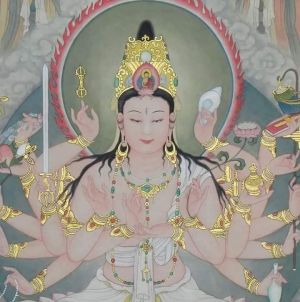Puja as Embodiment Practice
Rudolph Bauer,Ph.D.Author, Juliette Perry, LCSW Editor
THE POWER OF PUJA IS THE POWER OF MANTRA
1. Puja is an embodiment practice, embodying the archetypical dimension of ones own awareness. The practices of the various texts and syllables are skillful means for bringing forth within ones own being luminous spacious awareness as the great affection within the context of beneficence and fierceness.
2. Puja in Dzogchen practice is not approaching divine otherness and entering into a supplicating, begging posture, as in: give me more. It is devotional as love is devotional, and as the embracing of life itself is devotional.
3. Puja is not primarily visual in the sense of seeing iconic imagery as reality itself, but as doorways, iconic doorways into the field of immanence and expansion, the field of light, and cosmological powers.
4. In puja one becomes what one is. One brings forth ones self in greater dimensionality and stability. In puja one works with narratives and is poetically lead into a fuller sense of the beingness of ones being, and into the presence that arises from within us and through us.
5. To enter puja is to enter the dimension of the sacred syllables which are themselves manifestations of divinity, as dharmakaya, sambhogakaya and nirmanakaya.
6. In puja one brings forth what is in one already. One experiences what is already there.
7. The experiences do come through the alaya which is ones historical epoch field. Ones own history does count.
8. One may say and hear words. This use of analytic language is only the beginning. The actual experience of mantra is when the inner language opens and the four levels of speech become apparent or apparitional. Arising out of dharmakaya is light, the light and sound as elements, the syllables, the symbolic realm opens, and the words and sentences manifest that which is being experienced.
9. The syllables are the cosmological energies manifesting in embodiment, in the subtle embodiment of the light body and the sound body. They are what they express. There is no signifier to something other than what is heard, felt or seen. They are the true and innate symbols. There is no reference to elsewhere. In feeling the mantra, the self arising mantra becomes embodied, and within the embodiment sambhogakaya and nirmanakaya are embodied. The subtle dimensions of sight and sound are also embodied; thus, bringing forth the body of light, luminous flesh.
10. The symbolic realm opens and in that moment one is no longer so concrete operational. That is, bound to concrete thought or concrete imagery. Rather, the diaphanous world is experienced and seen into and through.
11. In saying the mantra verbally and hearing the chanting of the mantra, the resonance of the mantra resonates to the mantric dimension of our being. The resonance brings forth the experience as resonance always does. As the mantra arises, it arises vertically as well as horizontally. In that relational dimension, radiant extension takes place as does radiant emanation. This brings forth the same dimension in the other. This is the power of mantra which is the power of puja.
